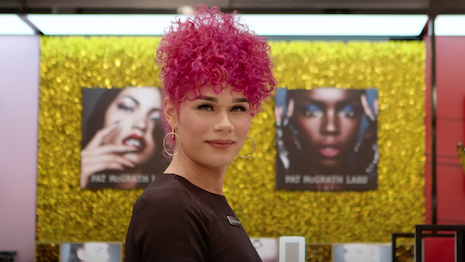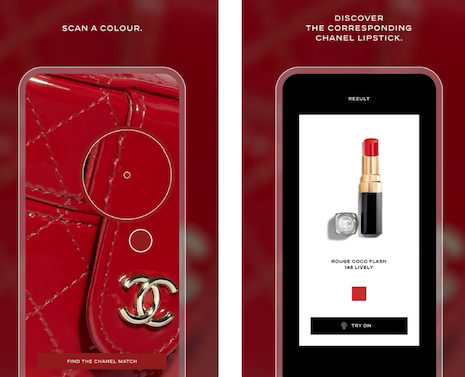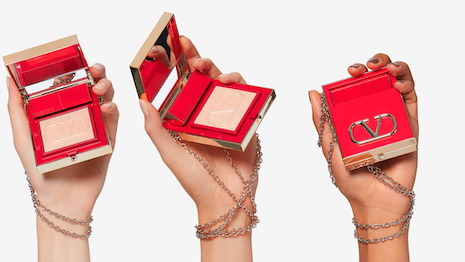The collateral mental and physical effects of the COVID-19 pandemic remain steady, leading to a shift in lifestyles, values and behavior.
According to the Fashion Institute of Technology (FIT) Cosmetics and Fragrance Marketing and Management (CFMM) Capstone’s research, “Beauty After COVID-19: Beauty’s Reformation and Renaissance,” the confluence of emotional shifts and technological development is ushering in a new age of beauty. To succeed in this new era, companies must adapt to these changes and institute dynamic strategies to meet consumers’ needs.
"The rise of 'languishing' in consumers is one of the most notable differences [in the last two years]," said Jamie O’Brien, CFMM Capstone Lead, New York. "This is a key element following the pandemic that reshaped the mentality of consumers, with 55 percent of respondents admitting to feelings of languish.
", or described feeling more restless, stagnant, or lower energy compared to pre-pandemic. Further, this percentage was even higher amongst the younger cohort surveyed, as 62% of those 18-29 experienced this.
For this report, the cohort completed an in-depth analysis including quantitative and qualitative research inclusive of more than 900 respondents, global fieldwork and interviews with global beauty executives and market experts.
Reformation and renaissance
The research depicts this new age of beauty through two approaches: reformation and renaissance.
The COVID-19 pandemic pulled back the curtain to reveal four critical challenges beauty companies and their employees have been facing for many years.
More than half, 53 percent, of industry professionals agree structure and policies often stifle agility and experimentation, and 80 percent are feeling burnt out by the five-day work week model.
Turnover rates are increasingly high, as 26 percent of employees admit they only plan to stay with their employers for up to two years. With that, 71 percent would look for another job if they were not offered the flexibility to work remotely.
 Companies should focus on more than just serving consumers and investors. Image credit: Sephora
Companies should focus on more than just serving consumers and investors. Image credit: Sephora
FIT’s Beauty Think Tank recommends that beauty organizations stop overprioritizing consumers and investors, and instead, see the industry as a network of many parts. In this way, the beauty industry can form, grow and work together as a whole.
The second approach to beauty is the renaissance. People are emerging from the grim COVID-19 period with innovations in art, culture and society.
Today, the lines between the physical and digital worlds are blurring, and consumers across all industries are learning how to exist with unlimited interaction with each other and brands. The consumer research conducted by the cohort uncovered four key insights on the post-COVID beauty consumer.
"Technology is perhaps one of the most critical elements of the shifting beauty landscape," Ms. O'Brien said. "If not for the rise of the metaverse, gaming and other technological mediums, our consumers would likely remain within the single-minded personas we’ve historically seen."
Among a cohort of respondents ages 18-29, 62 percent state they have feelings of restlessness yet experience low energy.
More than half, 57 percent of consumers have changed the way that they find and interact with new people since early 2020.
The majority of consumers do not trust brands as 66 percent believe companies and brands are acquiring and keeping their personal data.
As digital technology continues to infiltrate physical reality, more consumers are accepting the future of “phygital” innovations, with the gap between awareness and interest at only 11 percent.
"With tech advancements, consumers are able to create additional, entirely unique personas that reflect their aspirations and ideals," Ms. O'Brien said. "Brands in the future must cater to the fantasy and escapism that comes with this territory in novel ways.
"Further, the experiential component of technology has the potential to be transformative in years to come," she said. "We see this today with virtual try-on, but in the future, the experience one has when shopping for beauty products may be more closely linked to technology than the tactical experience of shopping in-store."
 Chanel's Lipscanner tool allows customers to scan any color using their phone camera, and Chanel will match it and provide the nearest lipstick shade. Image credit: Chanel
Chanel's Lipscanner tool allows customers to scan any color using their phone camera, and Chanel will match it and provide the nearest lipstick shade. Image credit: Chanel
With these figures in mind, corporations should be strategizing new ways to develop deeper, more meaningful connections with their customers, while also supporting employees and adapting to the changing workplace.
Brands at work
High-end beauty brands and retailers have been exploring the possibilities of augmented reality technology in recent years, but the global pandemic accelerated innovation and created new expectations for the shopping experience.
In early 2021, French fashion house Chanel joined the AI voyage by introducing a new lipstick color-matching tool, Lipscanner. Using artificial intelligence and virtual try-on technology, the brand can match any color to its nearest lipstick shade.
Developed by Chanel’s Makeup Creation Studio, in collaboration with CX Lab, Lipscanner allows users to upload or scan an image of any red, pink, plum or orange color — from a street sign to the petal of a flower. In return, the app provides a range of Chanel lipsticks in the same shade (see story).
With emotional tension and a shift in personal values came a greater awareness of environmental issues, and beauty consumers increasingly demand clean products and transparency.
Beauty group Estée Lauder Companies became the first luxury beauty company to join the Supplier Leadership on Climate Transition (LoCT) consortium.
In joining the group’s initiative along with other global businesses, the company intends to accelerate climate action throughout supply chains in an effort to reach net-zero greenhouse gas emissions (see story).
"There are numerous factors triggering the sense of languishing we see in consumers, and the dismal outlook on the climate crisis may be a factor, especially amongst Gen Z," Ms. O'Brien said. "It creates a balancing act for brands as they enter into this new consumer landscape.
"Organizations must make decisions that are aligned with the digital shift but will not have a negative sustainability footprint."
{"ct":"Mdjozs1jqUe\/8aPmdnmZI0VvE2wGIxd3eyGtDvUqczazUmGmAwzMI4dsihPNYuZa5v3eIya1GeK9nbFpGpXxQpO6g6ZJU7R1CWFlcPhP7htnvl6mma5U2Rt8oGM\/TEXv0gpiVx3+tPyhmi7pgeg+OwaA1B7P5F5+o9s2m8V5f7Kq7d3l1uj1nS2lJhCalYPf9aGnueS7iDN+viIRGJ9scHsVlUcikZajEz9R\/WFqJuhH+3qlPQ93DvB66OVEDj+ZTNQinPKxgk67rykvz8vQqzdAuB0vOsCguu2YqIThumuTGznc1uNweYWV5TR0Dk2pUx7cN5CLqI0S2nGA1jjTut++1y6iOkwDvogHDk3OKaNDNVFZHwZofbJOcH+ru+TE3SyxLtU7jWzSNLjFlEVboboEtEW9GL9YgoPo0fbIvrIWNz+sU7jYAcVG9av1w3W7PfP2AomwHJnyqwKmx6ROPfTpEMciMfhfiHMxBhk64OOo\/51UGBrkSeRtSIYR4nqr6xtcHcI6ZT39tf9FccAfMvozEgIPFKOhOskLZgXLMPh6lpmb6qfGVbFIRY+e+oLPI2hx5ZBHaX\/BIFN5QheDUyFHoYrUiPuyeKIIBQlqesV4eTqki+ZYNKXYn7vHiSNtehmEnmHXbyr19kqqUgpoY78rDe17nq8KTOrUqfDU43TDg3ue+kW8OtAe8CUiQySdgxVUAjzpNqCo9YBuKauwVXnWZ6iK6N9qO89CchIq9wwT8mdnHM86LZtUIgfO7Z1FNd6mJrPWqX7Q0+eRvcMzEZxy20n8bnjT037EFfADmtusRs29z+SgTLBSBHUPXO5IkC0VIuc8bxE\/4m19h\/ZJt2xCwA4UjvJtFIfQuJRM1lABamkEis4Gun9Hg83Ks0hCBU01Gt5Y8L0Gss4DZMtO5peqX9mQH37yzpQ2Ijzn15MLgl5ylbTNtjTW4g0e7D8gGzNGVs2+SZHhwxmLm\/IvXPTwhbX4RYBvs5VzHVCYyLbPl5fp7\/rGvDOdDiBqJo1njRVKoyQOTjc2ZCqh\/2PQFnyhhM78z6ZCn83gcpeQmnJHuyeR1I4+noUmV6aNq06\/oMnUF4+VFo1qmt6Lo\/Y5sxrMrh2Tp2MqF2BRS+eyMwO00+hmRJ\/wKdmMl5S4xs23IzCLk4A7zLqUV6tsYqD31obcWIbp9q+vBsvAg\/th2uTABNjnn09ilTPYaNO+4dDzvA4PhhZsxq132PbS45lpM+\/zjzG2W\/Yz3yQWsVq5vIPij54oODmOMWZ\/lCJBAtJEvbxwal9YEr6Pvz7uus06X8io3FqZoMcfGj2\/efK8ZNyPWn+bE\/GuzWa08ebbxYe4gUei6ixIQmVSAnk0sdIjO0f1otkFHQ89YJjwni4Al3IlKbek9n0pP6eM0+\/ZG1tVZJ4y3nODUrcbQSLbCjOTMYabmY6EwQOhDIkxXWf\/MqgozxVJvwAU2DCp0qHoKC4OKDodYlnFo2y8cOsCK+Ma9LD0bxqsXQdBczAGl9z3O+wbUOdB4gixaFpKOUME3BkdHRrtrCiqHxwhzJgaEObylyX\/e9Bj5tvAPunYY4zKsEeP5N8\/1m4wpQ10DyCwbrkTiUHkI291RrOz8QPYthFBj\/EQ7ImXbTs4hVKgsP\/5o3BmmgrCc1QOH0cqQ+fLCiPIBjQbq1EhC\/hUm4\/KoOP9iXiGgGe3BGO4jGXU2\/Yr1ae4Yh\/1jtJch6m8CDoa1fskSM7R3nwTstU8Gcj\/\/8EGyFj+ggBeRYNDNrusSWaX9ij6kvUAlGzWMWllbvntnoZVSp8Rce9UJx4dk6bak8jTY4qqlU0KdeW77OQ\/xEe3pxOPXFybSoQmT13k1SDkb0TY04xeuTQEEruJeECKQQJDbjLR1zgwIp1h+G7g\/5KCSjo3HYsltVE31ELsvi2MI+0Z4+Q0v18GYmKlSq+7yLFCVZXPO+G1Vwtsu5AgwzU8HvNTlowa+vobqb4\/K4XfYmSqYUlHr5zagfzBdGKNRR2lNcgwbGrLsy+HD\/LGG6AvSlv9jCxzDzlRF32Zi7bEvdSnzQM47P7OUVxzPrEsifzqIko6rWRhPSD\/EQPZJ3m0SWmIig57Bdb3deN97ZJ1SV6n1Lk6joMxrWNFIls4lMsWEGhBun2U\/A2qTEBnlNFTRsbZ6Oh5zKgUaM8wMOfR+Kx4LDqRUZjPK\/aFBoMAHUUb8J89or53hTVt\/wDTz22F6DH8dRiY76bFkUSTBbiT8uJBGBLsrS9jCsOAgtBQjArygjYp+DXNti9zKu9uqoqCMEC+secShvC+wMRqzU4XIlbSKp7ZIE9MuAQc+tcpvJUeDAue\/2k2MnNEjGNd1qttVf3pCwjwC1XavWMkZ9mmoFEJVXhi6ZqowUG9Jp7Yq+yhW7FNwcBQaGcj6JMDRJpnKorrnCvj\/3SRhDKrB9SwRaOhTFXfaxunn1\/ojO9IjB7s0sGKWZzesgtMgapcRK4byVniS2yxHoWWqk2iSUuZ6HXP90VTAM\/MTsfTG1Mmn57GCc7hFj2q3gXXETGP5ALX4QMIOsw5H7+2vNlh+5GbpRfmog01Y67J3vMH7WQ8QY4o93hIykHjo+zYtgqpvTP+m+2dRVL64IttNGGO4nMQjtmlIefkHsk1jwW2OzvVmsQF0qCydgjHW7uG970TPMj0ZKg85iJQrqpO5Ta8lbgg2o0hKzsd+QDIDksV+7SLtv32GcrQ2Ucy1z59qi7FWr8+eo6gb38S2njk2kw\/Hb4iso8p9oM6+AHngMvmcvIjnjXKy1upPVkarPhQHPJznk5OizcdtOcsjSQN+8PERSHqlcex69\/cQFnF4RU4v2OW+ZjHrgJlU7dQROk2dV1IhbHmKXJNoKfEomkzLljhKMCQCqP+eWbs\/w5rCT1oJA6CMPiO\/iUXmdPAducvXdBE4zK9XbOfVMqK7jl0iw0Jqcj\/zQxxQQnBVG11iiDzWp+GFamW3OA6P4BEiIZEaIYbyY4OpK4UmkeTPT6DAsMENtRfbkaxJh47pN4zSYYKgenbFNP8\/75h01hzQBlQmi3T4g1CvkUSv6akSSLjVWlc3fx9y06edHUBgpQLBfBt6+0sI+ideMLvYluTlV0wlcvpQb0+vN5mvYzzw9NnSWffSwpquN70GjJ0m+zTKJLXZzWta\/AqRycDNtF45jwkdEjHGIE0h9Vx1lTyFHzwTGR9oL1L812zeUk\/sqjumvJGMDPyQv1eMJ2CeFeS2F5syX\/NCCoN8Rp5pcfG21QnNXYQt6zNMOEzvgsDd4gomqEDhdUtaRp7UsQYwzPGoSZij2J91YJrZa++I48lSbyGlZdoVHBxk12VC\/4qmiEYLacy+UWW8UtnXHLtvWo1shwAQIuP0AKeEQLBjt0BFlfeWlAR1OBKvds5VsKVLVqGFKE1WLkCSxR1NM6kOHAPZN0N4WPWodjTRY6iUVB3cQxqZ0S2ZrSwjuNbKQQ8QaodiijLcqedZwbbrNbzs5Ya4C8hoLssN3aAdnJD2\/dBfM\/gN2mnKHqxXMm00pIKL\/Km+7\/Ks+KBBjEuvhhGVG\/Kce\/YEr0VDpuOF3KPFGOdeKxp9CctkUAAm66YPsXya9\/H+qU+mq1GDJuNKCaSjbStBHgsOhn+xiZdD8rDN8c9BGKXkaqFomkyDdD\/H7IH2rzZtXU9kvz7WEremmIeUqZEf5IGFGRfSFK\/w+fPX\/65KLHKrwcukMQf44kM\/fsQFbcsl\/dpdLZG+oFOqYTbXm2A7dEIEG\/DSYTipuywSSu6WN1miTQRg0ei0Y6mCC7C\/m4WcbI2ZgMzCEB7Xtdbzmw62jggpBw3U50gM2mfh4DY1uI3Is0wnkv48BymOfrFh9Lse6DQYuW2yuDVmUiBIvC6IfLnb8kKHQz4axHTuH0HWxd21AcyeJm\/9Rar\/MQh6xICRficsvSP6nZchWE4lDG0oEhUvOYA32wa4Ff1iYadAWZlLEPapteElGBa\/+lliNqy7CZUa4Bc5b2XEIUeJtoovebLzyDAxJwYN2cmxSPBpyn9Ce1BhhrkhhvKO2F4H7Bsb37YkXRQQwtXnLyLtHPBTiBizyOqlVRaRTDDIIENESiomQoC32twkuPIXgTglVbj2LXvNlcFLig8pfp4b6qO7bIEBodZbY5NKB6rr4tHJ671B3U7xZezjr06avCtYcWFKWOIZttoqqAT1NGr4PZlvhnFxAJnci0aA8qDwbpAesaqqKtSK+jtEKDsvMAqVJNq3qf6VUPC+uz1Xt9o5wWR+E2YyKSA\/LXhT3Ecpga9dJiPNVrAJohTX+qNkuwY6jqoTOgGcIMG9d23s0MtZXxdoZlbeHXtUlzx\/fPqFtrQO9c7rfyym0OBnPWH9Qdyb0AzXuZXIyZU72ifbp55PT\/QpFmLif1H9oRGleDZ0vVumuUnngc5S6MDF7ntJVDBNpcR4BYEGkeRmACKSkd7jimZfAWF2b5JKKXdfkbNfS8l9p1Ye9PFPH2US2AQvszHyLMvg7u+sXK3a7NMTb2DBeV9cXvTOJgeRaqJo7MsY\/Mw5Bvybw20it2\/eAmyntxQ207C4\/oJL6H2E887BV5kCF33DtyRBwPeXX2ewDktYFzgePTQKdc8aB+FkOFJLwWSpgYA\/7sfs\/bJDY6rriMPMSMyb\/BqLHrNhOjbUtzyV3BcenLm8UGHBUtKDP72Gm7ehx6S2dF5\/PkN7bJGKVliyOP7Uou++2lDmtEyUXFxGvEfNsjP8j+gBp1nF41Vu1JFvWtahTuumF+Z8XKruwsyJ\/Pl2keAehJQNp\/w8Z\/+CJqY7qYeqZH\/LIMtrvmjPoTA6yIGiuEsXzIU+sO1nBTf97VE\/ITlYlz9cUu2YI8mA5a2Bis9dug35RWdqBDB2DktA8KDDM0nD7\/e7ea257TyAkQZYcNzAUmOAqIEAO3QLmFDfIROJ2hWGIGMAUa1etxKZ0lYvKYAMHT\/KQ2AeyU4MiOdjxz8lCWnVmtDqxlvyyZnZzV7ZqW\/ePQnpRV5Lc2G12AdDJp2oZRn3GOldKnmSdqiyALStrh48rYjPPRHfUFBfyKUrrNnUQV60AQ5iRykhMVEUEvuXaCszc7jX\/9he03QbJa\/tOwBk6fRwhl0SEpRs740TYSL6OKfk3IlsObBlob8hyCvYw1pyppkaw6Q9WBTUzDY9c3MxyHsbShGTElAHprzg\/F20jz7N7DGu55\/TAiXVysB2weQTSfWIEMN+hYeDl08ayW73CUBEYS\/KVgWehSsHetDiqYATz0QZTZxFG+YIVakFqlevrOSzFFpn0lbJZBHZ9siYXdIGqjjSqbBX0TiVhkNzhSo3cXxY0TBEQmyf+5ByFR\/R3hNPPUwvQr2J3X39bI2W+xDT6ttjqQt+GLs++iT0EwW\/zWayG3maYKQjB3+nWwhM3xBfqNUWAZ3uL2SfqRhGUGpxK8KW4ZOMhm93IqMng0DQhySANQp33wycjJH1hIuKs80\/P8ECjtFGtfsiMFWs0X1u4e+n+ksl9Fig2N4LlEDVlVao1tWlyEtosnplA9OxWw\/UdKv+j9onb4ute9URL0mYUkquPt+YbajM+LKqyR8Po9SpRnjNz28puTBe18z6pelhuJdyv1eg10z4KPVdlEtABcadrqpszEe3PZaSLEHyhsniDHyc3JiRrrIMYIzgsZSztwYrP+KKro9Kf\/loSEe8nbWxaMkSuOz03uiFw8FOWC7ZxlVjoFnLYz8fUWZY5CYWHpJHsh7AIasih05tsd7d\/VvDuDU2toaAVmb7Lp0Zz\/\/BRxPD1\/vJDKMKfxL\/WhMRyWIL5yqCZWWWuvflg9IwmnEAh1hFOMs8odZIZ+GG5YZOKjTvdgCk6LbX\/UR8hcOR\/KCN\/Wz2P91voRIFUj4No2z6x2EYmbckpPKa1C6jP2DKQW+OJ2UjNtYtFNNnhXQRawGyJHYOd8NLTcbx57hK0g7rz+3WysxuKLuqW8DAxmOUkltEOuusCWmWX6X16cdv8QQBwGbNyyPnRo2uj\/XbWKJwxXvHTnxeEFTRLx9dsU2h8cBcf6rzWt57eLwSwh55ORSN0vJNOP8TiT3csEsBAiNMX0tNZq07dFqinCG7FCfX2mAQvfkuB4abVg36QXx3MWXIXH9Ga9WdfIq1Edw+jmwddowDGN+MUbOYyG03TsMcZ49rYi4OX6h0VOvHlH+HZ+h3Sl4LZOtN12i8wPWajok0\/3Kb+hpVbuDd2KUbnmUj+O2pgZu\/xN1JwE1Yt78Me1v1lecZ5y+tet6lXCKBjT3M0ThRZt1Sjwn+MLt0No0Lmbsi1rcVmOGF+gH2SH\/nnb9wWAptLzmal9NMnjmT+BeSEHGjVaHDS5\/pqKCcnWEaG7puszYETOiuW6+h2jSOwVRzDd\/ElXvsA2Cg4W\/FZxDJHVbOxOsLJKlBvmh9hUK6re+BaXorNbX5bu+wuaxoGVcoozx0W\/64A051kmtgb7ZiOi6K1a3Kaz7Kzg5\/lFk0MPnMNydNpwwEDGLYBhF2nXWiWMTJo\/Fru9qdtRWz9yf84i1CoRM+GsdePo4cCg0TxR75KeDeupXEhG5ltKAPNzqfpa\/L43q8YmFpbEr13LArR7sFB+OPsYJ4u7OYTCb\/y5JfNF6WuWu2kuC+EEPxs1UhbjglyHLJ\/iHiyTcT97lwBAJ6kFxETqVMPOIrQ7oWcDh\/kbfa8Twx\/bT0g7dFkZ2fs2kDCWzjcoIEmGK22IhX+Ph5VPWLui+RC6MbhSoEIA8Jp+qugJgmltpQce6MpziPCZk8RiLi8enw8IkNG+Yd0x4KELf0Kz\/KZvatI424SiPMHJ1JVoT63H7FzF6gM3thNVZwyi\/DvJOdpS8so9c6HiOpLnL+EeRm8VafFk8aXQ9P6npsC7uOmfJ177Kf2faRkIvB0z6vn1B20sRl3JVZsE565FQpJiSqjtvKM\/eBCXHeDqDlfQWb7Lj5Qca7ME2Qg8oQKFSl24GZkrSiGZNlx8h5nYdLq0uYvqMKZbEyESo74tqowdiw72vKPFWKPtdVE37mKUTIxqGjZSg0RwGESg4CGlxViLEVoS694v1bSI\/L+o0f1R+2hMvV0OX1JixD0gKoFNyVyTRxJRCjx0r6hAchCYHyF+u\/f77lK+B0Th0dZWG832cP3pOk+TKgAJEdmqbqyBHNbZss4iKQLhc+TTc394ji730nRbA1EPx6BoOWZY7cYI5NRTchRnWY3oNgr1FXZZiLvnP3Fml\/borC7aiLG7OuZezSX\/JiBurQvrcB33QLawHsltkYJjF2ElLUWGx5rOJlSYxAV1CF7fpRC20VPsQtm+Y+eP86IRA63MHlv6T5q2O27I3bC6KQiXHfyemyuQ1UsSFU2sO2QYmVBmtDuNGjrsWEXTE+l4EDpzf15\/l1AmfIT71Q8WJ0uZoNwK8aMwNR6CokrXOjDsyqihO2rNbrfxjULk+tYmKGXTvnBRRuKkdSb2Ee6ERIAk0+ustAQ6e3dEhWdzOdHbh1pyLuJN6msCDUJ1njs9dsCChBPQ88RrFsFI7i9XErXMaNvYs34evcjvTahhA7FUgGKTn0uwJja5WQ6A5lPDo43AmqEjmROytucYMAw0pN2mvP3SQjcI3AkoCs+CKL94AuzMmuSUzC7BChlXIEOuML8+tNyolp39hsodjraIBQwkyOAtIIuZTDzNgQZxm2ZHnV+Na+gDmlNxgIAgKxovsHDGZT66PMcKPn9laD5e7Ithmof1dqrMob1KQ4nuuVfFDz6N8fXhaZV7NE8Vryq+E7ClTEELW5pDdNgi4hhHLZGDYbE1Npgxel6k7YBwzdbKkkfLjeKtRaXqiRMvpLULCsRXBYrdcW7ShJD73AYhBBpT0JVioZjqtsGa3k3efxdUNpifFVqOig48mvbZ3Qx6ZrZMcr2NJScl9YgeGz\/mTGrkDGPvf5yKD58eLLQctu43nohosMK3qlyNCDg0bmfkWSxzzMjw13xQpKTrKk1elzZovNVgyXqGMMyKxXDujbD6MfJLCCI\/d2ruGcP+4zVrI9IntQPHHF8o1Sip+STEPgwE79vQIrc0DDpwAjKr4ENRQvN3XCtIuuXpXd2Lm+Y\/g4bVHuz4nAhur8Daz8pk0yvmGbcujfWIhLzVo9MUOQ\/T68TGjoHueww8HUyGjpkJ4aIYOmSYTgm9IIs75lKJbV4BExEVUps4Rp+ypmlbnj7\/4a6me8uOvp+1swss5pdv55PMj3UCns6X\/yCpabYZ00qUlVzLALvPlXUxCvaWTEW5SWDUY3DAWp1HM6M2Ja5AwaRlNUxIp1RTJ\/Sg6\/EpzwTVtXNVjFQCHfx9JN9IcMWycUXOBQBLWA60maxmx209SLxO9iESwtYLAP1dJtFV5D92ThArvkWil8pXENOaVwyRZSDYbIRyGaOA4hlll0ehYr1dXlkDgTBg7xoxXQvh+yIbKkP1guv9AjlwQo92TCPcpuPGG1EaCIhe3AJnKBiwRV2gGJPGiWP8K4gx\/6bgciXqiCLFxZ9Y0ajve3u+7wgSGnpiLRLriuzmnJB1Lm\/pQ4IDtcz0c5y+kJyvJmXBvV9maElm38J+miQQdMFP2rDV5njmORQBNPdbebtD4quYKFqu\/qbwsi1fXejK0fpJtk1UKVII71K59yVNnJMJnOFVAvUKh5x5jVtBdgmMbxSaDkL95r\/DckSAhmDpMXbTpGIwtWwhF5EP1VsXcWjJikAVvKgwnrGmGxNm+QJpfsfLdA9j+0Lt8uf9vSIBw0uclX\/3opiJvpMzaHoEZRtzKvOUvDLah4z2v5eaWMyZ2fSI1H4vAND+sMdb2\/Lk1X9aj4noCmGEoZZNtkFd59Mt9ueqBqjcNmUZcCGUgtQmZhGA6ar7AnSzrPkxYLbtxcRAfnzeuaXLJjgc\/3Skj594LWz\/Xak7KuBosg8ZhHerKyTcs+F6o\/lIg8KJ5\/Syrs2YonLhElc2oNwU\/z54h0W+XljHR1ORhwykLI6HwBY1qAXIJT6O7Ct5leFdYojPeNlq8HEL68lRJUJUx+MdURcABnMHBtWuuUgzMFBzMm8QeZx6rN32ei1DRZWY3c\/d1+uHMNuXLOyff4U1t7L0HV2v+\/3j8DDMNkCilCkhPp2VvE2L9lKa\/OmqErlGxCDkfkCVtqQI8kOfh5whasHGVzggt4Co0DtnaUzDuD9NtEdWy8sNTMjDqhjMn+T0DY6sgEf+LDlkG7SMIJA6wEx7PJAhwDiAnZKJdsBoWfQ2g71u3nfR+yiOZVqwXaMvfSYvDMLyLHaRKo1JQ+aoJkOqPnRQhfqr3zNmtvFYZn0b9G4j2o\/QvJQaPmVM1FlJOmsaG2jwQXlWAwYX1HCnZPj8QTqIiH3qmDnvTSzcl3iU14+89m0X2B9DNlxLkS\/jZ90VYVTYRtxK4Rwj13NSSd7ZOpe\/pcJyPAfHGam07ZltI7ysNX\/5xbTQUgnhVPprxdiNMf9FRJhVeY+SDiz+0CG57w5RfwVS\/d+6iY5KsgduPEGZXUdfbtZfqEC2AQ2sqnulXjl28nRmlRyqFZg7JPT1vNjdDaT5EB+i9YL+0NYe92ynv3J3bMvYpzO8t0EPySth\/XR0JLJ6uP2vgHwNEwPGtBtsb+avTPixbLVHZP3UDQmc6LztP\/+ss+HHNo4WDRAZ7NZOkMNyh5RJaKEV6uvIJA\/61sJ5kXa+dzSw0zpXP1+RJx7BPx8hIZTV10BmO0fRiLrRhS2xyhIw0SzL1dpahixsu\/TAVgf+bHaaKuKvXrem2l1curh3Iv0O8Rk2vx+QZQDSDGOsL7MroPAaqIoCppeVFOT\/SPacRuAL7NWM5TUAyZASZMUKNEGjd75sGuciBDGhjyimv9aePNCNjO1YPYFUxu9Jd3tKxgeVzhylHCqFudtJOXcC0wZzAou6MKBZAecSseTXdhoaBJ2BveVIDSUJXYomEv38imslqtjZcVZ3b4DIUWA5k4WxHRTm0jCV4DQAYE85G9gy6XkZKlCnRwpitcYJUvnnb6feqMingk\/ueLPTSueKbbD41WlZlNhXGY+U1k2RXSp3gnDhQriCNk8hWrKblNsBsF0UqbVZWO3FdtGGaxQ7gtHR8EpOG6gL1i5QTkRaz76j6eQvl6enAZtKlSI\/Cnuw5xCdJbZIgoyd6RE\/24lRx3xW2hIISLm1EwnUfiFAgWkP5D5B69ey\/h0dUcurYghBXgE4hUvqee61P2rjl+jyDOeGxzMDpAaFXnIZnc\/gYJYfrieG5GynsbsS6J0WzCVQDHLL2sCSdHwQ2pl47MRuXQEeVW7T+sJHuO+eyznyy4Ja4m0wQzGyuPzKOyivZ2GeEh0TKX732iJJmFVvpIIPKa745V1\/6Wj3K6czqY7G1jKsUbw8caFaZLjtCS5DPmTmgNITA35YbgU3w+HOQnN42uIjTXPa8+U+sRGMZM63oMQjLQITDQaA64dDLK0CYI7SV7ySulym7sayG9TkCUhYDmbcTVkpKlIRkZiwrq\/dVP8nnj9rVCCmRzIVYRsXqQ1ktcgyRcN4o0tCFt+EEK49h+goooLedEryBG3qLBkIW6VrljrUxpQziwCD7EM4=","iv":"2ac3e514784207ceb6debc84adee44e0","s":"772334573f2dc8d8"}

 As consumer values and behaviors shift, so should brand strategies. Image credit: Nordstrom
As consumer values and behaviors shift, so should brand strategies. Image credit: Nordstrom  Companies should focus on more than just serving consumers and investors. Image credit: Sephora
Companies should focus on more than just serving consumers and investors. Image credit: Sephora Chanel's Lipscanner tool allows customers to scan any color using their phone camera, and Chanel will match it and provide the nearest lipstick shade. Image credit: Chanel
Chanel's Lipscanner tool allows customers to scan any color using their phone camera, and Chanel will match it and provide the nearest lipstick shade. Image credit: Chanel